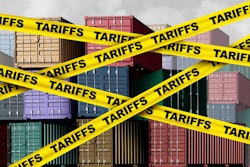The National Motor Freight Classification system can be confusing, but changes slated to take effect July 19 are expected to streamline classifying LTL freight. The National Motor Freight Traffic Association has standardized density scale for LTL freight with no handling, stowability, and liability issues; assigned unique identifiers for freight with special handling, stowability, or liability needs; condensed and modernized commodity listings; and improved usability of the ClassIT classification tool.
Contents of the video
00:00 10-44 intro
00:21 Changes to the National Motor Freight Classification system
00:53 Reasons for changes to National Motor Freight Classification
03:04 Preparing for classification changes by the go-live date: July 19, 2025
04:51 Impact for LTL carriers
06:56 Major carriers are ready for updates to changes to the National Motor Freight Classification
07:49 What shippers need to know about impact to cost structure
09:03 Helping LTL carriers improve utilization
Speaker 1:
Changes to the National Motor Freight classification system take effect in July. What does that mean for your trucking company? You're watching CCJs 10 44, a weekly web episode that brings you the latest trucking industry news and updates from the editors of CCJ. Don't forget to subscribe and hit the bell for notification so you'll never miss an installment of 10 44. Hey everybody, welcome back. I'm Jason Cannon and my co-host is Matt Cole. The National Motor Freight classification system can be confusing, but changes slated to take effect July the 19th are expected to streamline classifying LTL Freight.
Speaker 2:
The National Motor Freight Traffic Association has standardized density scale for LTL Freight with no handling, STO ability and liability issues assigned unique identifiers for freight with special handling, STO ability or liability needs, condensed and modernized commodity listings and improved usability of the class IT classification tool.
Speaker 3:
For those that are in the industry who have managed or been responsible for shipping LTL, it makes a lot of sense, but for those that are outside, it makes no sense because it was so complex in the past and what they're really trying to do is make it simpler, right? And the complexity in the past was that there were thousands of item numbers that represented different commodity and the factors are pretty simple, right? It's how you handle it, how you stow it, meaning how you put it in the trailer, the liability, the value associated with the shipment or the product as well. And in the past they had thousands of these in a book and you looked them up and you said, okay, this commodity that I'm shipping, feathers has an NMFC number or a number that is associated with it, and it's a class one 50 and because it's class one 50, then you went to an index or to a rate base and you said, okay, because of Class one 50 from Denver to Dallas, it's going to cost $600 that same lane with an item like bricks that was class 50, it might cost $150.
And it was all designed around the fact that at the end of the day, the LTL carriers are trying to maximize the density and the weight that is in the trailer right on that lane from Denver to Dallas. So what they've done is now simplified it to say, Hey, we're going to get rid of all these different NMFC numbers. We're going to consolidate down and say that hey, feathers are this item number, and if you can compress them and make a pallet of feathers as heavy as a pallet of bricks, we're going to be able to ship them for the same cost. And so we've looked at our business and about 45% of all the LT L activity that we manage is being affected in some way by changing from a class based NMFC to a density based tier class system.
Speaker 1:
The changes should give carriers greater visibility of what they're carrying and its effect on payload in both weight and volume incorrectly classifying freight with incorrect NMFC classification codes can result in higher costs making it essential for all NMFC users. And that's carriers shippers and three pls to prepare for these changes by the go live date of July the 19th of this year.
Speaker 3:
The things that have changed, right are one, the LTL carriers no longer rely on each of their local terminals to input and or to collect the actual data on individual shipments. So one of the things that has definitely changed is they've all gone to automation of some sort, right? So they're using scanning technology that is visually looking at those pallets as it's coming off the trailer and they're digitally matching what the description on the bill of lading is to what is physically being handled. So things like overhang or overhang. So if I build a pallet today and I have six inches on all four sides, I may put on my bill of lading that hey, the density or the cube of my shipment is the product, but not necessarily the pallet itself. So they're going to begin LPL carriers are going to say, Hey, the density is the pallet with going vertical and not just the product that's being shipped. So what changes is the accuracy of the bill of lading needs to be improved by many shippers, right? And we've taken some steps to do that. I know other providers have done that. That's one of the recommendations that's out there. But what will change is an LTL carrier will rebate that will reclass that and will drive that to a density calculation. That probably means that they're going to see an increase in cost as a shipper.
Speaker 2:
The biggest winners are LTL carriers that are often stuck with odd sized and weird shaped freight that has a large footprint preventing fleets from packing on additional load and optimizing trailer space.
Speaker 3:
Any customer or any shipper that is shipping something that is harder to sow, right? That the so ability of how that Tetris of filling every cube in the trailer, they're going to be the ones that are going to be affected more. And there is some positive for this. I think one of the things that people haven't really talked about is it was 11 tier density calculation in the past and they're going to 13. So the more dense your product is, so think about laminate flooring, right? Very easy to stow. It stacks on a pallet. Very nice. It's very heavy In the past, under the 11 tier, they shipped at class 60. Well, they'll now get the benefit of shipping under the 13th chair at class 50. So their costs will actually go down. But to your point, if you're shipping carpet on the other hand they go, we'll just stick with flooring. Now you've got a 12 foot long piece of carpet. They're going to see some changes in their cost structure because of the STO ability of the product relative to how dense it is in terms of the cube that it takes up. Why is it this happening?
It should help, once we get through this, it's going to help with fewer disputes, fewer reclass. I think it's going to more accurately help shippers understand their cost to ship product. And one of the things we've told customers is you may have benefited from the past way in which the year cost may have been less than they actually were. And so from a shipper standpoint down the road, it should help them understand their cost to serve better. And certainly from the carrier perspective, it's going to help them right from a revenue standpoint, and it's going to help them accurately cost what it does take to serve specific type of shippers with specific type of product.
Speaker 1:
Now, if all this is news to you, whether you're a shipper or a carrier, you've got about a month to get ready. The good news for carriers is July's launch date, really just formalizes processes and technologies that are already in use.
Speaker 3:
The carriers have been, they've been pushing this, right? And as I mentioned, most of them have dimensionalizes. Some of these carriers have integrated the ability to weigh that pallet on the forklift as they're moving it. So they've been pushing for it, they're ready for it. Most of these carriers are using the CSI cost intelligence system that's provided by SMC free. So they're all using that as a way in which the cost and price their freight. I think they're looking forward to it as a way to generate additional revenue. I think carriers at least the top 20 carriers, if you look at the North American market where five or six make up more than 50% of the total capacity that's out there, they're ready for it.
Speaker 2:
Shippers, on the other hand, need to understand how this change is going to impact their cost structure.
Speaker 3:
The challenge that they have is if their WMS or their TMS or their OMS, whatever system of record they're using, if they have an updated to get accurate information on the bill of aid, they're in trouble. And every rules tariff of every carrier says if you put inaccurate or incomplete or expired NMFC numbers on your bill of lading, we have the right to do X, Y, and Z. Right? Whether that's reclass it, we weigh it, bump the class by to a class one 50 regardless of what the shipment class actually is. So the shippers, if they haven't already done so, they really need to make sure that they're accurately filling out their bill of lagging. And obviously we're helping our customers with that. Half of our business or half of our customers aren't transportation management customers, their warehouse customers. So we've been actively helping them making sure that whether it's our WMS or their WMS, it has the accurate information in there when that bill lady gets created, and whether it gets transmitted electronically or it gets physically handed to the driver, it has accurate NMFC numbers with the accurate density for the new 13 tier
Speaker 1:
Breakout. The change too should also help LTL carriers improve utilization by giving them a better idea of what a given load may look like before they ever actually put eyes on it.
Speaker 3:
So in the line haul sense, meaning once it's been picked up, brought back to the terminal, and then commingled with other shippers and sent out LTL carrier is pretty good at that. But what we saw specifically post COVID was you would show up and you used to pick up, let's say seven bills and 12 pallets. All of a sudden you had 24 bills and you had a full trailer, right? And so the p and d part of LTL shipping became very inconsistent, and LTL carriers struggled to understand what they needed to put out on the daily basis to do the pickup and delivery piece. So this will help LTL carriers better understand that piece of it. And if you transmit that information electronically versus in the driver of the bills, you're giving those LTL carriers the opportunity to do some pre-planning that in the past they had to wait till they saw the freight, right? And so, yes, it will help them from an overall density standpoint because ideally, if you're going up the road, you want 44,000 pounds of product in 53 feet of space and many LTL carriers, they purchase some of their line haul transportation, they run some of their line haul through ups and triples depending on where they're at in the country. So you're right, this will help them maximize their utilization as well.
Speaker 1:
That's it for this week's 10 44. You can read more on ccj digital.com. While you're there, sign up for our newsletter and stay up to date on the latest in trucking industry news and trends. If you have any questions or feedback, please let us know in the comments below. Don't forget to subscribe and hit the bell for notifications so you can catch us again next week.








